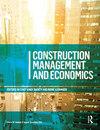外部能力的可靠性如何塑造工业化建筑公司的模块化战略
IF 3.3
Q2 BUSINESS
引用次数: 3
摘要
摘要企业在进入工业化建筑时会模块化。先前的研究强调了其模块化战略的重要性,认为企业可以在内部建立模块化的能力,也可以从外部获取。为了了解是什么塑造了一家公司在模块化战略中使用外部能力的选择,我们研究了三家领先的建筑公司。在这项多案例研究中,Alpha、Beta和Gamma是亚洲市场的领导者,在高层工业化建筑中使用钢筋混凝土解决方案。在有外部能力的情况下,我们的分析表明,公司为使其可靠所做的工作,以及他们使用外部能力的选择是由其可靠性决定的。阿尔法在几乎没有外部能力的情况下进行了模块化,因此它在内部建立了新的能力;贝塔选择利用外部可用的制造和组装能力,使用标准、远程监控和控制产品架构,使其在模块化中使用可靠;Gamma在外部环境中拥有可用的能力,最初试图使用这些能力,但出于可靠性考虑,它通过收购公司将这些能力引入内部,从而实现了模块化。我们的贡献是展示确保外部能力的可靠性如何塑造模块化战略。此外,我们已经确定了企业可以采取的行动,通过以下方式使外部能力可靠:(1)使用国际标准,(2)质量控制程序,(3)控制产品架构,以及4)获得外部能力。我们为寻求向工业化建筑过渡的从业者和政策制定者提供了启示;并讨论新的研究领域。本文章由计算机程序翻译,如有差异,请以英文原文为准。
How the reliability of external competences shapes the modularization strategies of industrialized construction firms
Abstract Firms modularize as they move into industrialized construction. Prior research highlights the importance of their modularization strategies, arguing that firms can either build the competence for modularization internally or can source them externally. To understand what shapes a firm’s choice to use external competences in its modularization strategy, we studied three leading construction firms. In this multiple case study, Alpha, Beta and Gamma are leaders in Asian markets, using reinforced concrete solutions in high-rise industrialized construction. Where external competences are available, our analyses show the work firms do to make them reliable and that their choice to use external competences is shaped by their reliability. Alpha modularized in a context with little available external competences, so it built new competences in-house; Beta chose to use the externally available manufacturing and assembly competences, using standards, remote monitoring and control of product architectures to make them reliable for their use in modularization; Gamma had available competences in the external context and initially sought to use them, but reliability concerns led to it modularizing by acquiring the firms to bring these competences in-house. Our contribution is to show how ensuring the reliability of external competences shapes modularization strategies. Further, we have identified actions that firms can adopt to make external competences reliable through: (1) use of international standards, (2) quality control procedures, (3) control of product architectures, and 4) acquisition of external competences. We provide implications for practitioners and policy makers seeking to transition to industrialized construction; and discuss new areas for research.
求助全文
通过发布文献求助,成功后即可免费获取论文全文。
去求助
来源期刊

Construction Management and Economics
BUSINESS-
CiteScore
7.50
自引率
14.70%
发文量
58
期刊介绍:
Construction Management and Economics publishes high-quality original research concerning the management and economics of activity in the construction industry. Our concern is the production of the built environment. We seek to extend the concept of construction beyond on-site production to include a wide range of value-adding activities and involving coalitions of multiple actors, including clients and users, that evolve over time. We embrace the entire range of construction services provided by the architecture/engineering/construction sector, including design, procurement and through-life management. We welcome papers that demonstrate how the range of diverse academic and professional disciplines enable robust and novel theoretical, methodological and/or empirical insights into the world of construction. Ultimately, our aim is to inform and advance academic debates in the various disciplines that converge on the construction sector as a topic of research. While we expect papers to have strong theoretical positioning, we also seek contributions that offer critical, reflexive accounts on practice. Construction Management & Economics now publishes the following article types: -Research Papers -Notes - offering a comment on a previously published paper or report a new idea, empirical finding or approach. -Book Reviews -Letters - terse, scholarly comments on any aspect of interest to our readership. Commentaries -Obituaries - welcome in relation to significant figures in our field.
 求助内容:
求助内容: 应助结果提醒方式:
应助结果提醒方式:


